COPYRIGHT, PLEASE NOTE
All the material on this website is copyrighted to J-P Metsavainio, if not otherwise stated. Any content on this website may not be reproduced without the author’s permission.
BUY A MUSEUM QUALITY POSTER
BUY A POSTER:https://astroanarchy.zenfolio.com/
Thursday, November 6, 2008
The California Nebula, NGC1499
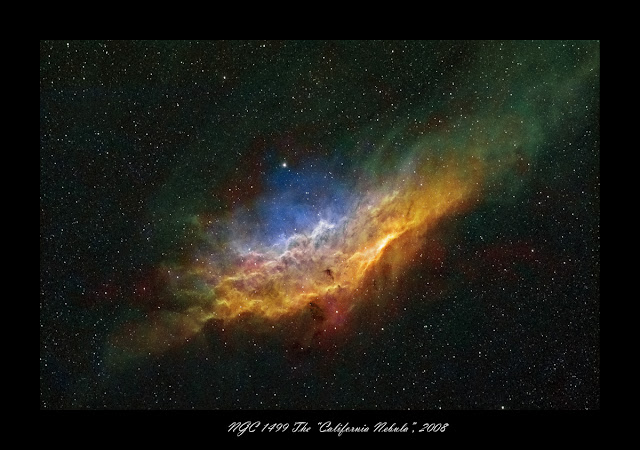 S-II, H-a and O-III composition, Hubble palette
S-II, H-a and O-III composition, Hubble palette 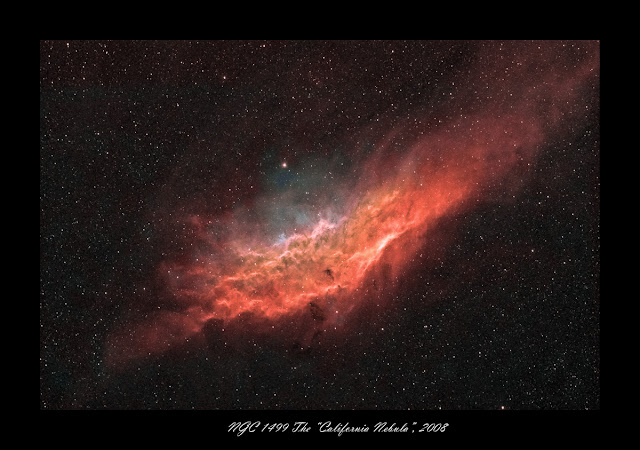 H-a+35%S-II, O-III and O-III+30%H-a, "Natural color" composition
H-a+35%S-II, O-III and O-III+30%H-a, "Natural color" composition 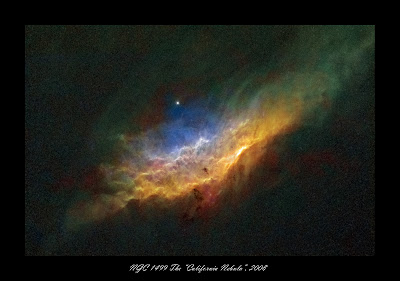
to better show actual nebulosity
-
-
This image looks very different, than images of California Nebula usually do.
There is two reasons.
First is, that this is a three color narrowband image, there is not
too many of them, least I haven't seen one.
Second reason is,
that image is "upside down" compared to usual precentation format.
I did this for a reason, narrowband composition reveals new structures in nebula,
they are very three dimensional and this position shows them best.
-
Imaging data: Camera, QHY8
- Filters, Baader 7nm H-alpha, Baader 8,5nm O-III and Baader 8nm S-II
- Optics, Tokina AT-X 300mm @ f2.8 - Exposures, 5X 1200s H-alpha, 2 X 1200 O-III and 2X1200s S-II + flats and bias
- Guiding, LX200 GPS 12" + PHD-guiding and Lodestar
-
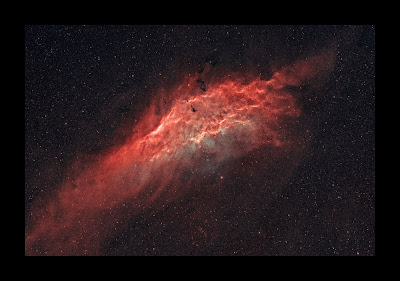
This is how Claifornia Nebula is usually shown.
Thank You!
Thank you!
Your support is very needed to keep up my observatory, art and publishing work.
All my published images can be found from my portfolio
Wednesday, November 5, 2008
Cygnus Trio in Stereo pair
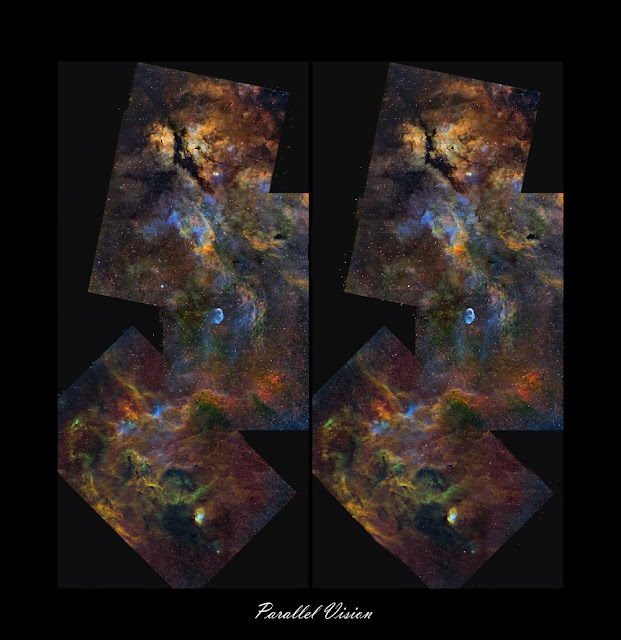
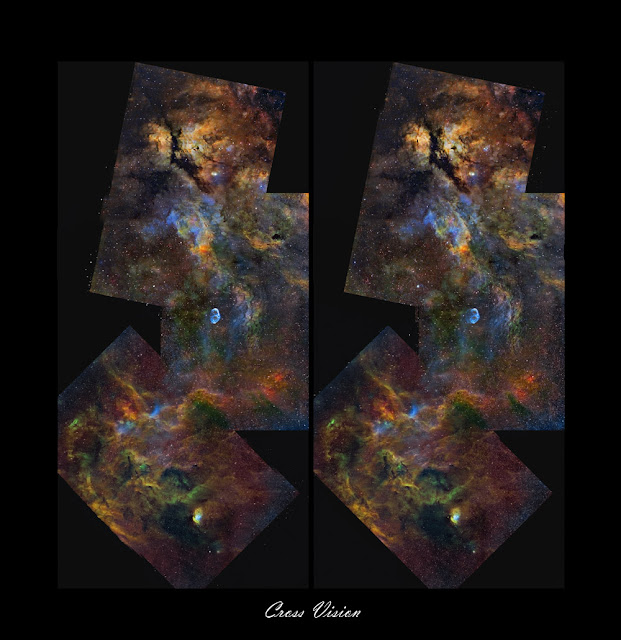
Again, this is not a accurate precentation of actual 3D data.
This is more like a "educated guess"
I made this one to show the actual nature of this target.
The gas and stars are floating in three dimensional space forming three dimensional forms,
rather than being a 2D painting on the canvas.
-
As usual, there is two versions. One for parallel vision, and the other one for cross vision methods. Thats because some part of the viewers can see one of the method in 3D, but not the other. (I can't see cross vision images
-
How to see this in 3D?
Please, look for the right hand side menu for instructions.
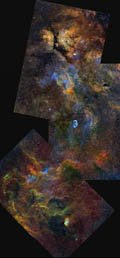 Klick this image, if you can't see either of the stereo methods above.
Klick this image, if you can't see either of the stereo methods above.
This is a animated image showing steroimage as a small animation.
It will gives an idea, what can be seen in stereo images.
Labels:
stereo images
Tuesday, November 4, 2008
The Cygnus Trio, a long project
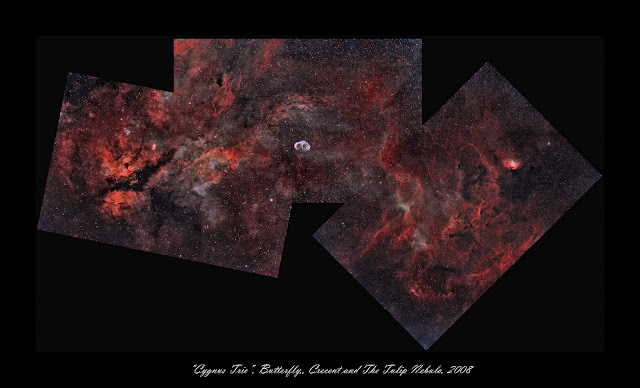
"Natural colors" 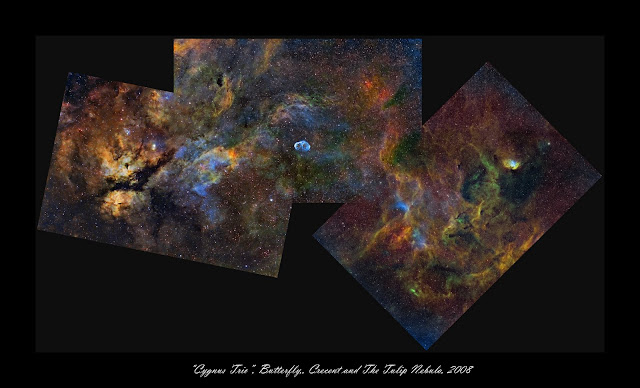 Hubble palette colors -
Hubble palette colors -
 Hubble palette colors -
Hubble palette colors -
The "Cygnus Trio", as I call a chain of objects in constellation Cygnus,
Butterfly nebula, Crescent nebula and finally the Tulip nebula are
located in Milkyway's dense star and gas field.
-
Image here is a mosaic from narrowband images, taken between 29.09-03.11. 2008.
Imaging information can be found in each images original posts.
(look at the right hand side menu, nebula)
The image spans area of 9 x 5 degrees.
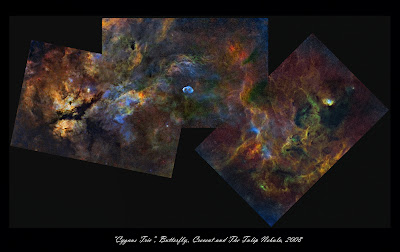 Here is a starless version to show the most complex nebulosity better.
Here is a starless version to show the most complex nebulosity better.The Tulip Nebula
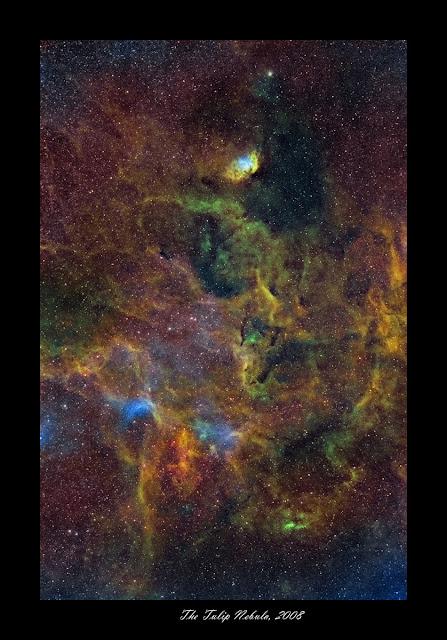
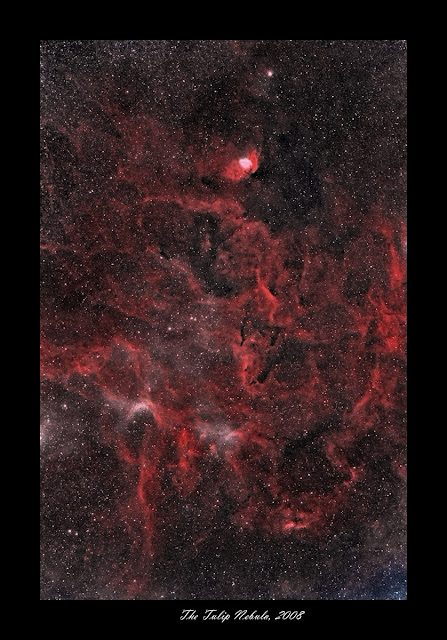
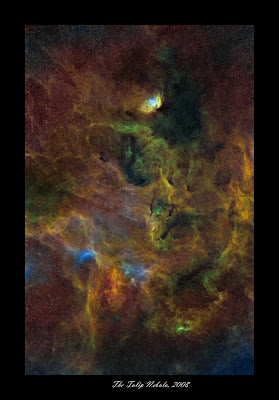
Last image for my Cygnus project is the Tulip nebula.
Image is a narrowband color image in different versions.
There is three version of this image here, first image is Hubble palette composition. S-II =RED, H-alpha = GREEN and O-III = BLUE
Second version is a "natural" color composition from narrowband channels, H-alpha 100% + 35%S-II = RED, O-III = GREEN and O-III 100% + 30%H-alpha = BLUE.
The third version is with suopressed stars to show the complex shapes of the nebula.
-
Imaging data:
Camera, QHY8 - Filters, Baader 7nm H-alpha, Baader 8,5nm O-III and Baader 8nm S-II - Optics, Tokina AT-X 300mm @ f2.8 -
Exposures, 7X 1200s H-alpha, 1 X 1200 O-III and 1X1200s S-II + flats and bias -
Guiding, LX200 GPS 12" + PHD-guiding and Lodestar
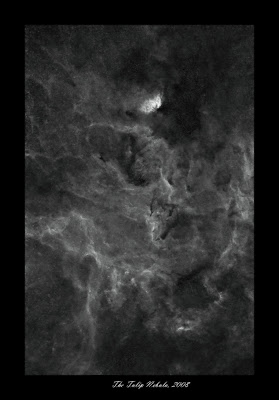
This image is a starless BW version.
It shows a three dimensional nature of this object very well, I think.
Editors' Choice

My Butterfly Nebula image was selected as an "Editors' Choice"
by Sky&Telescope magazine.

Monday, November 3, 2008
NGC6888, the "Crescent Nebula"
 NGC6888 in Hubble palette
NGC6888 in Hubble palette  "natural" color version
"natural" color version  H-alpha channel
H-alpha channel
I imagined the "Butterfly Neula" 29.09.2008.
At the time I left NGC6888 out of the field of view
to be able to better frame the Butterly nebula.
You can see part of the NGC6888 at lower right corner of the Butterly nebula image here:
-
At this time I wanted to capture the Crescent Nebula with the surraunding nebulosity.
NGC6888 is usually seen in longer focallenght images but I found wider field
as interesting doe the colorful and detailed nebula structure.
Imaging data: Camera, QHY8 - Filters, Baader 7nm H-alpha, Baader 8,5nm O-III and Baader 8nm S-II - Optics, Tokina AT-X 300mm @ f2.8 - Exposures, 4X 1200s H-alpha, 3 X 1200 O-III and 2X1200s S-II + flats and bias - Guiding, LX200 GPS 12" + PHD-guiding and Lodestar
-

I made a small mosaic from NGC6888 and the Butterfly Nebula.
The colorful "tale" of the Butterfly spans trough both images.
Sh2-224 & Sh2-223

In this image, there is two supernova remnants!
Both are extremely faint. Exposure time was 15x1200s = 5 hours,
and in final image there was very litle information.
I wanted to try this difficult targe to see can it be imaged from the city center and
with QHY8 color camera. After tweaking the data about an hour, I was able to say, it can.
Image here is a false color image, H-alpha = Red.
-
Imaging data:
Camera, QHY8 - Filters, Baader 7nm H-alpha
Optics, Tokina AT-X 300mm @ f2.8
Exposures, 15X 1200s H-alpha, flats and bias
Guiding, LX200 GPS 12" + PHD-guiding and Lodestar
Sunday, November 2, 2008
Cassiopeia A


Supernova remnant in Cassiopeia.
This target is most difficult to capture and process.
I never realise how dim this really is. "Cartes Du Ciel" gives surface brightness
for this object as low as Mag 37 !
Fast optics, Tokina 300mm @ f2.8 helps to capture those few photons.
There is some internal structure details visible in S-II channel,
they can be seen in Hubble palette image as red.
More information in Wikipedia:
There is two version of this image here, first image is in "natural" color composition
from narrowband channels, H-alpha 100% + 35%S-II = RED, O-III = GREEN and
O-III 100% + 30%H-alpha = BLUE.
Second version is Hubble palette composition. S-II =RED, H-alpha = GREEN and O-III = BLUE
-
Imaging data:
Camera, QHY8 -
Filters,
Baader 7nm H-alpha, Baader 8,5nm O-III and Baader 8nm S-II -
Optics,
Tokina AT-X 300mm @ f2.8 -
Exposures, 12X 1200s H-alpha, 1 X 1200 O-III and 6X1200s S-II + flats and bias
- Guiding, LX200 GPS 12" + PHD-guiding and Lodestar

Is there a outer burst in Cassiopeia A?
This starless image might show a hint of it.
Subscribe to:
Comments (Atom)










